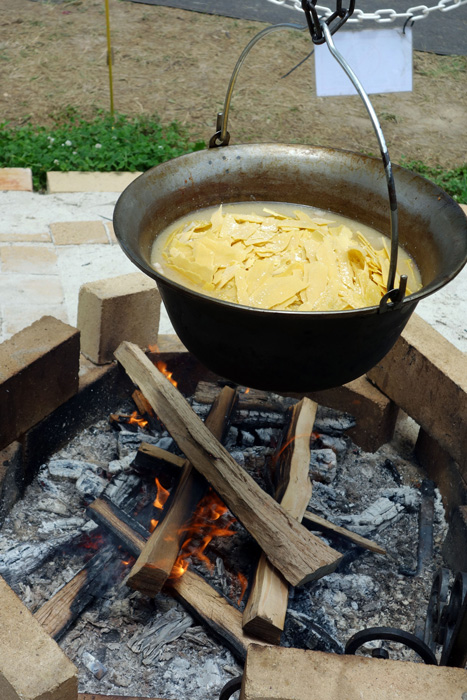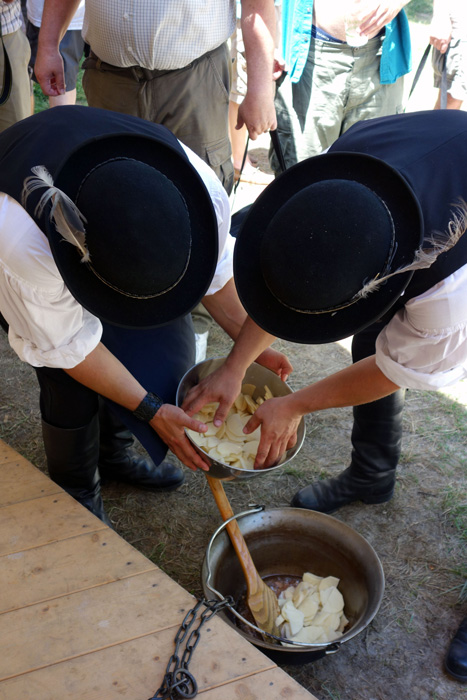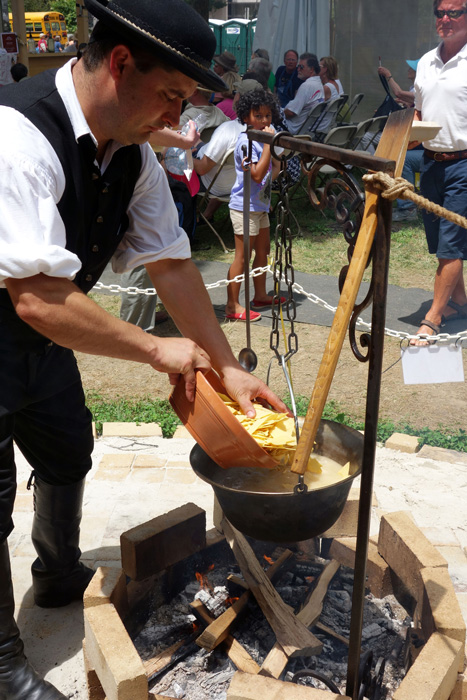Hungarian Recipe: Slambuc

Cauldrons were bubbling over open fire as usual yesterday afternoon at the Hungarian Heritage program’s Cauldron Cooking area, where the Csontos shepherd family of Karcag prepared their famously delicious version of slambuc.
Salmbuc is a traditional and hearty shepherd food made of thin sheets of lebbencs pasta, potato, and bacon. It stands out in Hungarian cuisine in that it does not use paprika powder as one of its key ingredients; the dish dates back to a time before paprika became available in the country.
In this version, elder György Sándor Csontos and his sons György and Péter use garlic as well as whole dried hot Hungarian paprika peppers to add a kick to the dish. Although slambuc may look simple, it does require some practice to make, especially in flipping the contents of the pot or cauldron so that the surface crisps up evenly.
Ingredients
1 lb smoked Hungarian bacon (any bacon will do, but for authentic flavor try the “European Brand Smoked Bacon” at Hungarian Deli)
2 cups of melted lard or oil
4 lb potatoes
2 lbs lebbencs pasta or very thin lasagna sheets (large squares, broken up)
1-2 whole dried hot paprika peppers
2 heads cloves of garlic
salt
Preparation
- Chop bacon into small cubes and cook in an iron cauldron or pot with melted lard or oil until the fat renders and the bacon caramelizes.
- Peel potatoes and slice into thin disks. Add these to the rendered bacon fat.
- Add enough water to cover the potatoes about 1 inch high.
- On medium flame, cook until it is halfway cooked, until the potatoes are tender enough to be smashed with the heel of a boot.
- Add a few pinches of salt, whole paprika, and garlic cloves. Let simmer. When testing the broth, it might seem a bit too salty and spicy, but this is desired. The pasta will eventually soak up the water, and the flavors will spread evenly through the dish.
- Gently place the broken up pieces of lebbencs pasta over the top. Add enough water to cover the pasta by about 1 inch. Whatever you do, do not stir as you do this! You do not want to break the pasta too much. If the pasta sticks out of the water, just push it back in.
- Cook this on low heat until all of the water evaporates. Shake the pot from side to side every once in a while, but never stir.
- When all of the water is gone, mix the pasta together with the potato with a metal spoon.
- Keep the cauldron or pot over the fire and let the contents at the bottom get crispy.
- Once the contents are crisp on the bottom, take it off the fire and shake it so the bottom is now on top. This can be tricky, but you get the hang of it eventually. If this does not work, try flipping the contents with a spatula, but take care to not crush the pasta.
- Repeat this every 1 to 2 minutes until the entire exterior browns up.
- Serve hot with a glass of red wine. A great dinner for a chilly night in!
To prepare the lebbencs pasta at home:
1 egg
5 ⅓ oz flour
1 ¾ oz lard
¾ oz salt
- Knead together the flour, dough, and salt and form into a ball.
- Roll out into a thin (quarter-inch) sheet and let rest and dry out over night.
- The next day, break the dry pasta into around 1-inch-by-1-inch pieces and fry them in lard until they turn yellow.







Lili Kocsis is the Participant Assistant for the 2013 Hungarian Heritage Festival program. She graduated from Harvard University in 2011 with a B.A. in linguistics. She dedicates her spare time to purposeful travel, food photography, and writing about regional cuisine.

